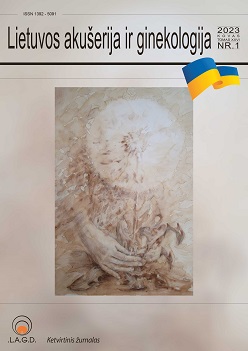ULTRASONOGRAPHIC EVALUATION OF CESAREAN SECTION SCAR DURING PREGNANCY – UTERINE SCAR NICHE AND OBSTETRIC OUTCOMES
Abstract
Aim. To investigate the prevalence of a cesarean scar niche during pregnancy, and to relate scar measurements, demographic and obstetric variables, and final pregnancy outcomes. Methods. In this prospective observational study, we used transvaginal ultrasound to evaluate uterine scars in pregnant women at 11+0–13+6, 18+0–20+0, and 32+0–35+6weeks of gestation. A scar was defined as visible on pregnant status when the area of hypoechogenic myometrial discontinuity of the lower uterine segment was visible and a scar niche was defined as an indentation at the site of the cesarean scar with a depth of at least 2 mm. Patient management and delivery were carried out according to the hospital’s policy, without taking into account the measurements of the uterine scar. Statistical analyses were performed using SPSS v 27.0. Results are described by their medians of distributions (Me) and interquartile range (IQR). The Chi-square (χ2) criterion was used or Fisher’s exact criterion. Results were considered significant when p < 0.05. Results. Overall, 122 eligible participants were included in the study. The CS scar was visible in 95 (77.9 %) cases. Of those with visible CS scars, half of the women had CS niche 49 (51.5 %). Overall, 41 (33.9 %) had a vaginal delivery, 48 (39.7 %) had an elective CS, and 32 (26.4 %) underwent an emergency CS. No statistical difference was found between the study groups with a scar niche or without a scar niche and mode of delivery (p = 0.802). The median thickness of the LUS myometrial thickness in cases of vaginal delivery was 3.4 mm, and the median LUS myometrial thickness in emergency CS was 4.1 mm, as in planned CS (p = 0.928). Apgar scores after birth were not statistically significantly different between these groups (p = 0.951). Conclusions. The CS scar niche in the first trimester of pregnancy was detected in more than half of cases with visible CS scar but not associated with the type of delivery, and pregnancy outcomes.

